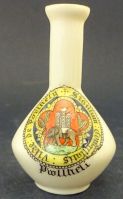Pwllheli
| Heraldry of the World |
| British heraldry portal Civic heraldry of the United Kingdom |
|
PWLLHELI
Incorporated into : 1974 Dwyfor (1996 Gwynedd)
The borough never was granted, or officially used, arms.
The borough used a seal, probably dating from 1442, when the town charter was confirmed by Henry VI. It was listed as still in existence in 1857. The seal, shown below, showed an elephant with a castle. There is doubt whether the seal is indeed ancient and not made in 1857 by the town clerk from his memory of an old design, but he was unable to provide documentary evidence of this. The seal, however, as shown below and reproduced by Jones in 1913, clearly has a medieval design in all aspects.
The meaning of the design is not known. An elephant bearing a castle is an old early medieval symbol for Christ and the hope for redemption, as well as a symbol for strength. In one tale, a young elephant is the only creature that can return a older, fallen elephant to its feet. The young elephant in this story represents Jesus Christ, while the rescued adult elephant symbolizes mankind’s redemption from a life of sin. This story conveyed to readers that the only source of salvation was Christian faith. These stories were popular all over Europe and in several medieval codices an elephant bearing a castle can be seen. Several medieval towns in Europe thus have an elephant and castle in their arms (see f.e. Beckov, Coventry, Dumbarton) and the composition is also used originally as a religious symbol in the highest Danish Order, the Order of the Elephant, since the 17th century (later an Indian driver was added for the Danish colonies in India). In England there is a story regarding the Elephant and Castle district in London and refers to a story involving Isabela of Castille. However the name is based on the name of a pub established in 1765, i.e. 130 years after the events in the legend.
In later years the original story/legend became less known and several legends developed for each of the towns regarding their arms. In the 16th century and later, similar designs were based now on the true use of howdahs on elephants in India.
The composition from the seal was taken as arms for Pwllheli on early 20th century souvenirs and postcards onwards in different colours, see images below.
Image gallery
The arms on a JaJa postcard +/- 1905
Contact and Support
Partners:
Your logo here ?
Contact us
© since 1995, Heraldry of the World, Ralf Hartemink 
Index of the site
Literature: Jones, E.A. Memorials of old north Wales, London : G. Allen & company, ltd., 1913, p.247; https://blogs.getty.edu/iris/the-implausible-medieval-elephant/; information from the town council (2022)

















